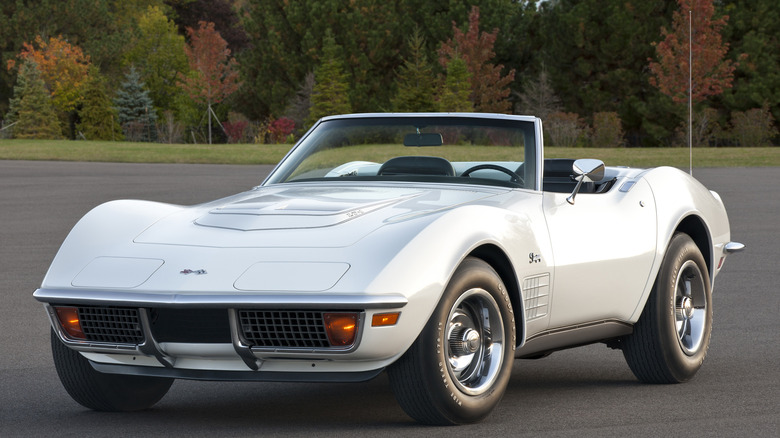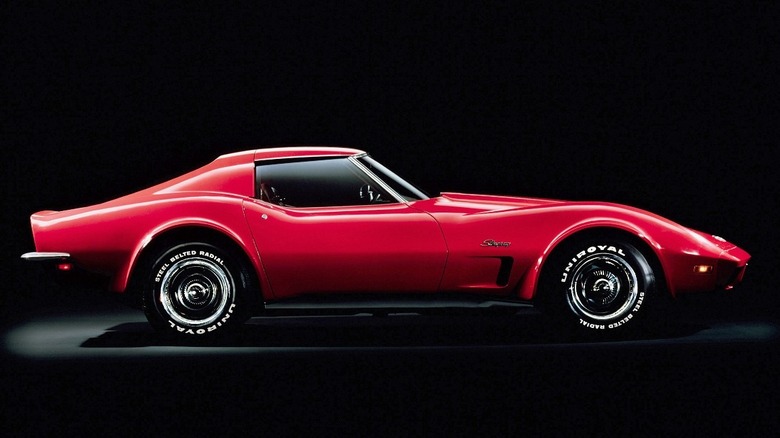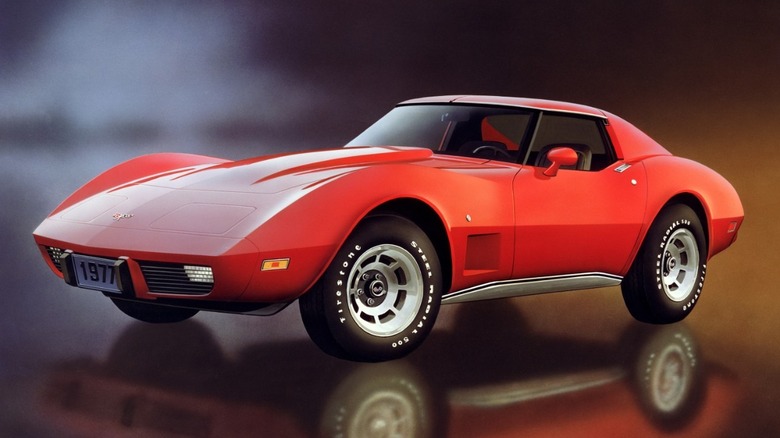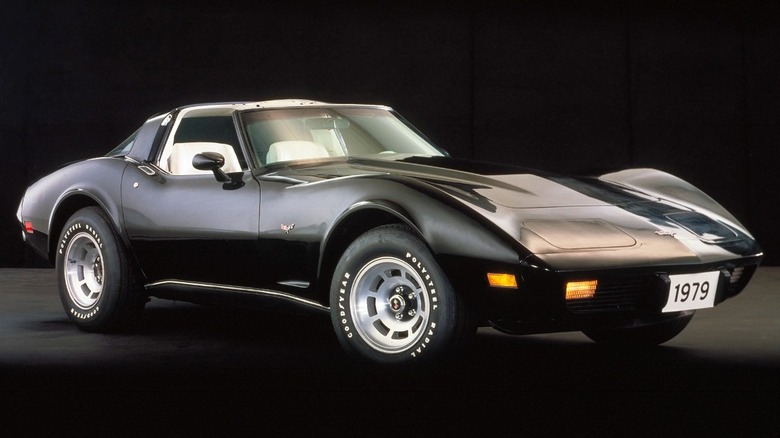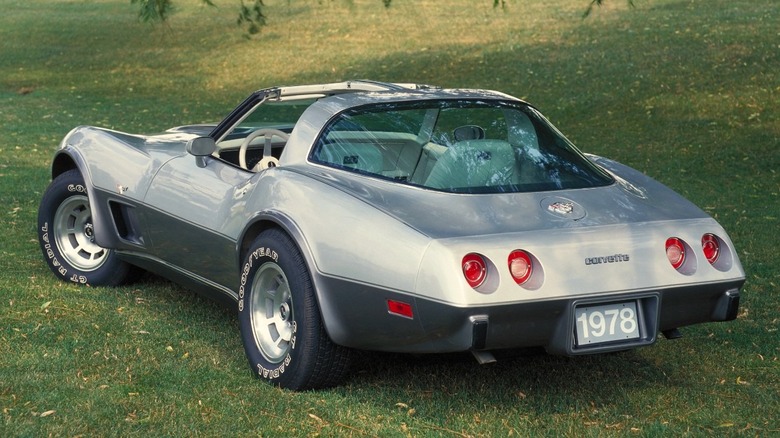Everything Chevy Fans Should Know About The C3 Corvette
The third-generation Corvette, now known as the C3, has the distinguished honor of the longest production run of any Corvette to date. Offered between the model years 1968 and 1982, more than 540,000 Corvettes were sold. It all started with a mid-engine concept car called the Mako Shark II in the mid-1960s.
Once a front-engine layout was settled upon, the production car was remarkably similar to the concept car, stunning the public with swoopy Coke bottle styling. Retractable headlights and windshield wipers helped create a sleek, uncluttered look that lived up to its "Stingray" moniker — now spelled as one word instead of "Sting Ray" like the C2 Corvette.
Initially, the C3 Corvette was offered as both a coupe and convertible. However, coupe drivers could also enjoy topless motoring, because the C3 was the first mass-produced vehicle to have removable roof panels, aka T-Tops. In early years, the C3 coupe's rear window was also removable, enhancing the open-air driving experience.
Although the Corvette's body and interior were all-new for 1968, the chassis and engine lineup were carried over virtually unchanged from the 1963-1967 C2 Corvette. Being that the C2 already had independent rear suspension and four-wheel disc brakes, there was little to improve upon except for the optional automatic transmission, which increased from two forward speeds to three. Engine choices included a couple "small block" 327 cubic inch V8s, as well as numerous powerful 427 cubic inch V8 "big blocks," cranking out up to 435 horsepower.
Change was gradual at first
The new 1968 Corvette design was not without some minor problems. Several characteristics proved unpopular with drivers, and therefore, were unique to that year only. Examples include a large diameter, non-adjustable steering wheel, ignition key mounted on the dashboard instead of on the steering column, push-button door handles, narrow 7-inch road wheels, and a blank space in front of the passenger seat instead of a glove compartment. All of these quirks would be remedied for the 1969 model year.
In 1970, the C3 Corvette's styling was tweaked with a new grill, revised side vents, rectangular exhaust tips, and fender flares that offered increased paint protection from tire-driven rocks and debris. The C3's engines also grew in size to a 350 cubic inch small block in 1969, and a 454 cubic inch big block in 1970. Horsepower levels were similar to the late-1960s models, although that would soon change.
By mid-1970s, new federal safety standards required bumpers which could survive a five mph crash with no visible damage. As a result, Chevrolet was forced to equip the Corvette with flexible urethane bumpers which were painted the same color as the fiberglass body, rather than chromed metal. In 1973, only the front bumper was urethane but in 1974, the front and rear bumpers were both urethane. Though some purists abhor the urethane bumpers, Chevy did a better job integrating them into the C3 design than almost any other car on the road.
Luxury increases, while performance decreases
During the disco-era, the Corvette's legendary performance was being severely hampered by a multitude of factors. The cost of both gasoline and car insurance premiums were skyrocketing in price. This was coupled with the Clean Air Act which necessitated unleaded fuel, lower compression ratios, and emissions equipment such as catalytic converters.
The 454 cubic inch big block was discontinued in 1974, a mere shell of its former self. Things got so bad that, in 1975, the base Corvette with an L48 350 cubic inch (5.7 liter) V8 could only muster 165 horsepower and 255 pound-feet of torque. Luxury options like air conditioning, leather upholstery, and power windows, while always available, became increasingly common.
After 1975, the convertible body style disappeared over a combination of safety concerns and poor sales. Many 'Vette enthusiasts felt that a convertible would never return, but a convertible re-emerged in the C4 body style in 1986. Later in the 1970s, Chevrolet ceased placing Stingray badges on the Corvette, although all C3 models are technically considered Stingrays.
It wasn't easy to keep the aging C3 fresh
By 1978, the Corvette was celebrating its 25th anniversary, and fittingly, some important changes were undertaken. The aging C3 body style received a significant refresh, including a new fastback rear window design and modernized interior. That same year, a Corvette was selected to pace the famed Indianapolis 500 mile automobile race.
To commemorate this achievement, Chevrolet manufactured an official replica of the 1978 Pace Car to sell to the general public. It featured an exclusive black-over-silver paint scheme, with red stripes and a silver interior. Only 6,502 Pace Car editions were produced — one for each Chevrolet dealer in the United States at the time.
Performance was back on the upswing, too. A 1978 model with optional L82 V8 generated 220 horsepower, and with a four-speed manual transmission, went from 0-60 mph in 6.6 seconds — making it the fastest American-made car that year.
By 1982, the C3 was truly getting old. GM executives decided the best way to keep buyers interested in the aging design was to preview the upcoming C4's fuel-injected 5.7 liter V8, and four-speed automatic overdrive transmission, in the final year of the C3.
A fully-loaded "Collector Edition" was also offered to punctuate the end of the C3 era. The Collector Edition sported a distinctive silver-beige paint color, special finned wheels, and a multi-tone leather interior. It was also the first Corvette to break the $20,000 barrier, with a base price of $22,537.
Current values are all over the map
With such a long production run full of revisions, massive differences in value exist between various C3 Corvettes, nowadays. For the value-oriented collector, the market is chock full of excellent condition, driver-quality 1974-1982 cars in the $10,000 to $15,000 price range that need little-to-no work to start enjoying immediately.
On the other hand, the 1968-1972 "chrome bumper" Corvettes regularly command 3-4 times as much money as the later years, especially for cars that are in particularly original condition and/or have a desirable big block engine. Extremely rare cars such as the 1968-1969 models with an optional L-88 performance engine can even fetch hundreds of thousands of dollars.
C3 Corvettes, particularly the less collectible later years, make for a perfect first classic car or weekend toy. With over 540,000 produced, they're inexpensive to purchase, can easily be hopped up via a ton of aftermarket parts support, and you don't need to worry about keeping them all-original for the sake of resale value. Not to mention the joy of a removable roof on a nice day.
